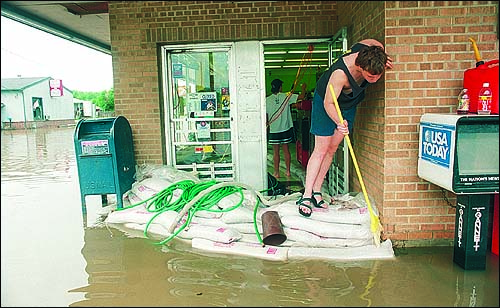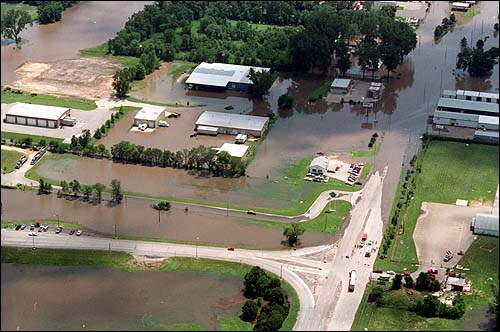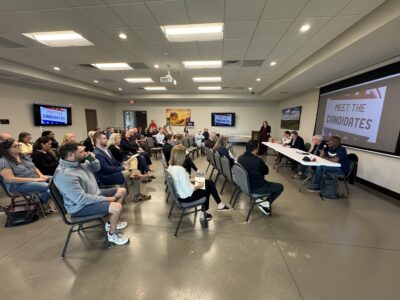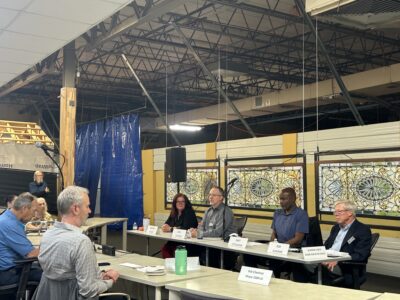Memories of 1993 come flooding back
On a July morning 10 years ago, Dwane and Dorothy Schaake decided it was time to evacuate their farmhouse just east of Lawrence.
Water had poured over the banks of the nearby Kansas River and the Schaakes were hearing their safety was at risk.
“We decided to go and we didn’t jack around,” Dwane Schaake said recently as he recalled the Great Flood of 1993. “We had all of the neighbors over here and we loaded up trucks and cleared everything out in a couple of hours.”
The Schaakes stayed away from their farm for about a week before they decided it was safe to move back in. Though much of their land was damaged by floodwaters, only the basement of their house had water in it, Dwane Schaake said.
Flood widespread
Others weren’t so lucky. In the spring and summer of 1993, flooding was widespread across the Midwest, forcing thousands to flee their homes and causing millions of dollars in damage to land, houses and businesses.
Flooding peaked in July 1993 in Kansas. In Kansas City, Kan., a half-mile section of Interstate 635 was washed out and the entire Armourdale, Fairfax and Central industrial districts were evacuated.
Lawrence — mainly North Lawrence — wasn’t spared, although according to City Manager Mike Wildgen, “We were probably the least of the problems at the time.”
North Lawrence hit hard

The former Roger's IGA in North Lawrence, North Second and Lincoln streets, is surrounded by floodwaters from heavy rains during the Great Flood of 1993. North Second Street is below water at left.
Virtually all of the businesses along North Second Street in North Lawrence sustained flood damage. The railroad underpass flooded and the city had to lease a pump from Dave Penny of Kaw Sand Co. to pump out the water.
“We recognized the value of using outside resources,” Wildgen said in a recent interview. “We got busy and started improving the drainage problems in the north.”
Since 1993 the city has obtained additional pumping equipment of its own. A list of a dozen stormwater drainage projects was drawn up and, with the help of federal grants as well as the city’s own money, two-thirds of those projects have been completed, Wildgen said.
Since 1994 Lawrence has spent more than $7.24 million on stormwater capital improvements and another $7.18 million for nonbonded expenses such as stormwater staff salaries, maintenance and related expenses.
The city also learned how to better coordinate efforts among its own departments as well as with Douglas County Emergency Management and the Federal Emergency Management Agency, Wildgen said.
Flood control worked
Despite damage and losses in the 1993 flood, the federal flood control system worked, or things would have been even worse, said Charles Perry, hydrologist and researcher with the U.S. Geological Survey in Lawrence.
“The system of levees and reservoirs did what they were supposed to do,” Perry said. “It was tested to the greatest extent so far since it was established in the years after the 1951 flood.”
That system was designed to slow down and hold water until it could be drained or released elsewhere. Operational lessons were learned, however. They concerned the specifics of how much and when to release water from multiple reservoirs.
Perry compared it to dumping two barrels of water into a bathtub that can hold only one barrel. Timing for dumping water from the second barrel has to be just right as the first barrel of water goes down the drain.

Low areas in north Lawrence are submerged with floodwaters at the peak of the 1993 flood. This aerial view shows North Second Street at right and the entrance ramp to the Interstate 70 tollboth at lower left.
“If you release the second barrel too soon the tub will overflow,” Perry said. “Timing is critical.”
Nature still rules
Despite all of the flood controls, the final result is still decided by nature. The 1993 flood problems started earlier. It was a wetter-than-normal year as individual storms often dumped several inches of rain in certain areas. By July the reservoirs were full.
The confluence of the Missouri and Kansas rivers on the border of Kansas City, Kan., and Kansas City, Mo., had come within two feet of the top of the levee, Perry said.
“Another 5-inch rainfall and it would have been over the top,” he said. “The rain stopped just in time.”

A barn and a satellite dish were partially submerged in July 1993 as a boater pilots through a farm along East 11th Street near East 1600 Road, just south of the main channel of the Kansas River.
The next big one
The area’s next big flood may not be far away, Perry said. The Lawrence area and much of northeastern and north-central Kansas have been hit with heavy rains during the past week.
Perry thinks it is a signal the regional climate is headed into a period of wetter years.
USGS researchers have come up with an analysis that shows how a three-year average of annual precipitation compares with a three-year average of flooding for two large rivers in the state. They used the measurements of the Neosho River taken at Iola and the Kansas River taken at De Soto.
The researchers have found a consistent 22-year cycle of excessive precipitation and major floods. Examples are 1993, 1973, 1951, 1927 and 1903. A quasi 11-year flood cycle also was found.
Research has further shown that the 22-year flood cycle is similar to the 22-year Hale solar magnet cycle and its solar irradiance. Solar irradiance is the amount of energy Earth receives from the sun. That irradiance can be estimated 10 to 15 years in advance.
Based on a study of solar irradiance and the flood cycle, Perry thinks the area is due for a flood sometime between now and 2005 and again in the years 2013 to 2015.

In downtown Perry, business owners took precautions by sandbagging storefronts during the heavy rains of June and July 1993.
Staying put
Despite the never-ending potential of a flood along the Kansas River, those who live near it generally stay put. Schaake, now 72, is one of them.
Schaake has no plans to move from his house on North 1550 Road to higher ground.
“That’s just part of life when you live along a river,” he said of floods.








